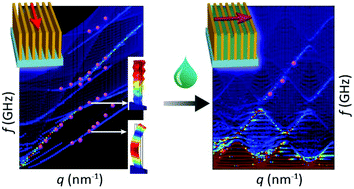Directional elastic wave propagation in high-aspect-ratio photoresist gratings: liquid infiltration and aging†
Abstract
Determination of the mechanical properties of nanostructured soft materials and their composites in a quantitative manner is of great importance to improve the fidelity in their fabrication and to enable the subsequent reliable utility. Here, we report on the characterization of the elastic and photoelastic parameters of a periodic array of nanowalls (grating) by the non-invasive Brillouin light scattering technique and finite element calculations. The resolved elastic vibrational modes in high and low aspect ratio nanowalls reveal quantitative and qualitative differences related to the two-beam interference lithography fabrication and subsequent aging under ambient conditions. The phononic properties, namely the dispersion relations, can be drastically altered by changing the surrounding material of the nanowalls. Here we demonstrate that liquid infiltration turns the phononic function from a single-direction phonon-guiding to an anisotropic propagation along the two orthogonal directions. The susceptibility of the phononic behavior to the infiltrating liquid can be of unusual benefits, such as sensing and alteration of the materials under confinement.



 Please wait while we load your content...
Please wait while we load your content...